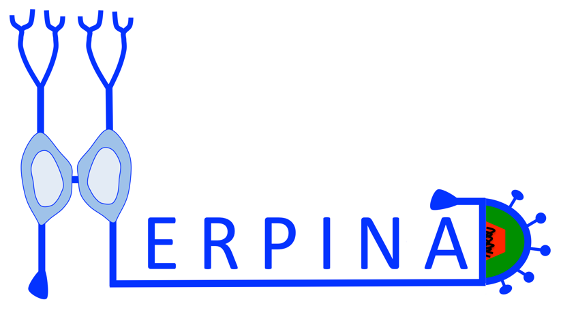Laboratory Main Focus
In the Laval lab, we study the pathogenesis of human and animal viruses infecting the nervous system, with particular attention to the associated immune responses. We aim to clearly address a possible viral aetiology and identify potential common neuroinflammatory mechanisms by which viruses initiate neurodegenerative diseases. Our lab is particularly interested in the role of herpesviruses (e.g., HSV1), coronaviruses (e.g., Porcine Hemagglutinating Encephalomyelitis virus (PHEV) and SARS-CoV2) and paramyxoviruses (e.g., Canine distemper virus (CDV)) in the pathogenesis of Alzheimer’s disease, Parkinson’s disease and Multiple Sclerosis.
Research projects
HERPINAD Project: Herpesvirus-induced neuroinflammation in the peripheral nervous system as a ‘distant’ trigger of Alzheimer’s disease.

Alzheimer’s disease (AD) affects around 50 million people worldwide. To date, there is no cure and current therapies are not effective in delaying progression. Therefore, there is an urgent need for a better understanding of the pathogenesis of AD with a vision of the etiology of the disease. In the last years, the inflammatory-infectious hypothesis of AD has gained support as an alternative to the amyloid hypothesis that has dominated the AD field for decades. In particular, Herpes simplex virus type 1 (HSV1) has recently received growing attention for its potential role as an infectious etiological agent for AD. HSV1 infects the mouth and invades first the peripheral nervous system (PNS). The virus remains inactive in peripheral sensory neurons but when a person is stressed, it can reactivate and return to the mouth, resulting in cold sores. Upon reactivation, the infection can also occasionally spread from the PNS to the brain and causes a lethal infection, so called Herpes Simplex Encephalitis (HSE).
In this project, our lab aims to investigate how HSV1 infection of the peripheral nervous system initiates AD pathology in the brain. Our work combines state-of-the-art technologies used in molecular virology/pathogenesis with cutting-edge methodologies ranging from high-throughput studies (e.g. RNA-seq, WGBS) to single-cell technologies (e.g. microfluidic devices, Ca2+ imaging). The most valuable and central tool of this research is our newly developed mouse model to study the mechanisms of viral-induced neuroinflammatory responses in vivo. This mouse model is the needed platform to test the efficacy of potential antiviral and anti-inflammatory drugs.
GOA Project: Impact of peripheral virus infection on the central nervous system
While there is a growing body of evidence that viruses may play a role in the pathogenesis of neurodegenerative diseases, the mechanisms of action by which viruses may contribute directly or indirectly to neurodegeneration are still largely unknown and for most viruses, there is little to no evidence for CNS infection. In this project, our lab aims to investigate the mechanisms by which viral infections of the peripheral nervous system (PNS) can potentially induce neuroinflammation in the CNS, in the context of highly relevant virus infection models in their natural host. Specifically, the project will compare PNS and CNS responses of three different types of viruses of pigs that are relatives of human viruses that have been associated with CNS-associated pathology in man, namely the alphaherpesvirus pseudorabies virus (PRV, related to HSV1), the betacoronavirus porcine hemagglutinating encephalomyelitis virus (PHEV, related to SARS-CoV and SARS-CoV-2) and the orthomyxovirus swine influenza virus (IVA) (related to human influenza A viruses). Using the pig as a natural, homologous infection model system, the project will address the neuropathogenesis of and neuroinflammation induced by the three different viruses and potential long-term neuroinflammatory consequences in the brain. For this consortium project, our lab will be working together with the labs of Prof. Luc Leybaert and Prof. Alain Labro (UZGent, Ugent) and Prof. Hans Nauwynck and Prof. Herman Favoreel (Faculty of Veterinary Medicine, Ugent). This project is funded by the Geconcerteerde Onderzoek Actie (GOA) at Ghent University.
- CDV project: Characterization of Canine Distemper virus (CDV) neuropathogenesis and its zoonotic potential
Canine distemper virus (CDV) is a Morbillivirus closely related to measles virus, which causes a multisystemic disease in dogs and other carnivore species. CDV infection affects the animal respiratory, gastrointestinal, immune and nervous systems, causing serious illness. CDV is endemic in dogs and wildlife populations worldwide, as commercially available vaccines fail to provide full protection against infection. Researchers have postulated that humans might also be susceptible to CDV. High titers of CDV-specific antibodies have been detected in human blood, and CDV antigen was found in human brain tissues. Still, the pathogenesis of CDV in humans remains largely unknown. Therefore, the aim of this project is to characterize the key steps of CDV infection in humans. A comparative study will be performed in humans and dogs to highlight possible differences in key steps of CDV neuropathogenesis between species. Specifically, CDV replication kinetics and immune responses will be investigated in relevant human and dog tissues: olfactory mucosal explants, peripheral blood monocytic cells and induced pluripotent stem cell (iPSC)-derived neurons. Unravelling CDV pathogenesis will be important to provide prospects for better preventive measures to control CDV emergence in dogs and humans, and better understand the link between morbilliviruses and demyelinating diseases such as multiple sclerosis.

